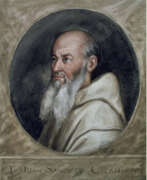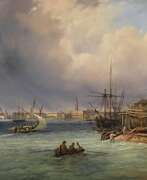Realism Venetian school


Juan Sánchez Cotán was a Spanish painter, born in 1560 in Orgaz, Toledo, and passed away in 1627 in Granada. He is celebrated for being among the earliest Spanish painters to focus on still life, a genre he significantly influenced before deciding to join a Carthusian monastery at the age of forty-three. Cotán's still lifes are renowned for their simplicity, featuring a few fruits or vegetables, some hanging from fine strings and others placed on a ledge, against a dark, almost impenetrable background. This unique style not only highlights the geometric clarity of the forms but also imbues them with a mystical quality, setting him apart from his contemporaries.
Before embracing a monastic life, Cotán had an established career in Toledo, accepting commissions for religious paintings and engaging in the secular art scene. His transition to monastic life did not halt his artistic pursuits; he continued painting, focusing on religious themes and the history of the Carthusian order. Notably, Cotán's still lifes, such as "Still Life with Quince, Cabbage, Melon, and Cucumber" housed in the San Diego Museum of Art, and "Still Life with Game Fowl" at the Art Institute of Chicago, are among the most emblematic of his work, showcasing his ability to transcend the ordinary and imbue it with profound spiritual significance.
Juan Sánchez Cotán's work is a bridge between the mundane and the mystical, capturing the beauty of simple objects with unparalleled depth and precision. His legacy is a testament to the power of still life as a genre capable of conveying complex themes of spirituality and the natural world. For collectors and experts in art and antiques, Cotán's paintings are not just visually captivating; they are portals to a bygone era that celebrated the beauty in the simplicity of everyday life.
For those interested in exploring the exquisite detail and profound tranquility of Juan Sánchez Cotán's work, signing up for updates on new product sales and auction events related to his art could enrich your collection and deepen your appreciation of this pivotal figure in Spanish art history.


Friedrich Paul Nerly was a German landscape painter. He studied painting with his father, Friedrich Nerly, and at the Academy of Fine Arts in Venice with Professor Eugène de Blaas.
The main themes of Friedrich Paul Nerly's work were Italian port, beach and cityscapes (sunset in the Adriatic Sea, the White Grotto in Capri, the surf on the Amalfi coast, the beach between Ancona and Falconara).



